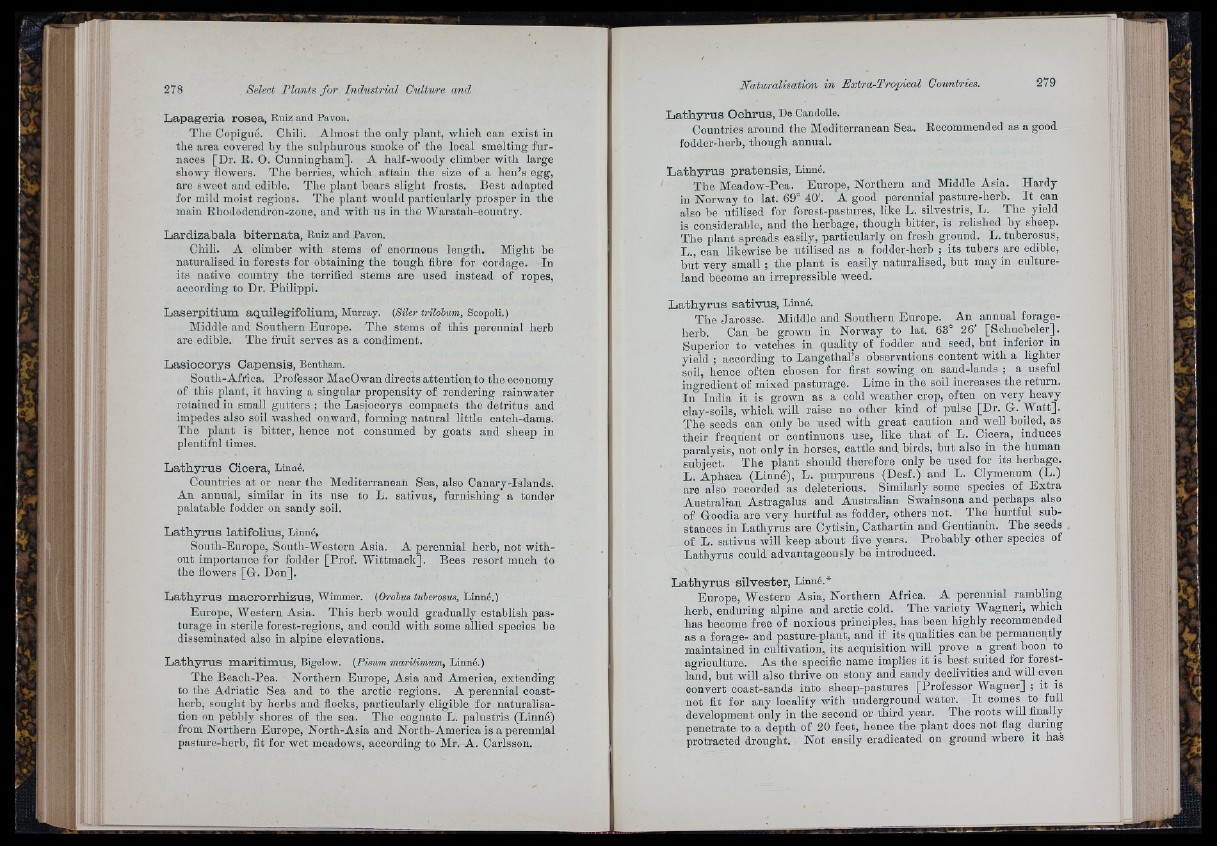
- t
í í
L a p a g e ria ro s e a , Ruiz and Pavón.
The Copigué. Chili. Almost the only plant, which can exist in
the area covered by the sulphurous smoke of the local smelting furnaces
[Dr. K. O. Cunningham], A half-woody climber with large
showy flowers. The berries, which attain tbe size of a hen’s egg,
are sweet and edible. The plant bears slight frosts. Best adapted
for mild moist regions. The plant would particularly prosper in the
main Biiododendron-zone, and with us in the Waratah-country.
L a rd iz a b a la b ite rn a ta , Ruiz and Pavon.
Chili. A climber with stems of enormous length. Might be
naturalised in forests for obtaining the tough fibre for cordage. In
its native conutry the torrified stems are used instead of ropes,
according to Dr. Philippi.
L a s e rp itium a q u ile g ifo lium , Murray. (Siler trilohnm, E,copo\i.)
Middle and Southern Europe. The stems of this perennial herb
are edible. The fruit serves as a condiment.
L a s io c o ry s C a p e n s is , Bentham.
South-Africa. Professor MacOwan directs attention to the economy
of this plant, it having a singular propensity of rendering rainwater
retained in small gutters ; the Lasiocorys compacts the detritus and
impedes also soil washed onward, forming natural little catch-dams.
The plant is bitter, hence not consumed by goats and sheep in
plentifnl times.
L a th y r u s Cic e ra , Linné.
Countries at or near the Mediterranean Sea, also Canary-Islands.
An annual, similar in its use to L. sativus, furnishing a tender
palatable fodder on sandy soil.
L a th y r u s la tifo liu s , Linné,
South-Europe, South-Western Asia. A perennial herb, not without
importance for fodder [Prof. Wittmack], Bees resort much to
the flowers [G. Don].
L a th y r u s m a c ro r rh iz u s , Wimmer. (Orohus tuberosus, Linné.)
Europe, Western Asia. This herb would gradually establish pasturage
in sterile forest-regions, and could with some allied species be
disseminated also in alpine elevations.
L a th y ru s m a r itiru u s , Bigelow. (Pisum maritimum, Linné. )
The Beaoh-Pea. Northern Europe, Asia and America, extending
to tbe Adriatic Sea and to the arctic regions. A perennial coast-
herb, sought by herbs and flocks, particularly eligible for naturalisation
on pebbly shores of the sea. The cognate L. palnstris (Linné)
from Northern Europe, North-Asia and North-America is a perennial
pasture-herb, fit for wet meadows, according to Mr. A. Carlsson.
279
L a th y r u s O o h ru s, De Candolle.
Countries around the Mediterranean Sea. Eecommended as a good
fodder-herb, though annual.
L a th y r u s p r a te n s is , Linné.
The Meadow-Pea. Europe, Northern and Middle Asia. Hardy
in Norway to lat. 69° 40'. A good perennial pasture-herb. I t can
also be utilised for forest-pastures, like L. silvestris, L. 'The yield
is considerable, and the herbage, though bitter, is relished by sheep.
The plant spreads easily, particularly on fresh ground. L. tuberosus,
L., can likewise he utilised as a fodder-herb ; its tubers are edible,
but very small ; the plant is easily naturalised, but may in eulture-
land become an irrepressible weed.
L a th y r u s s a tiv u s , Linné.
The Jarosse. Middle and Southern Europe. An annual forage-
herb. Can he grown in Norway to lat. 63° 26' [Schuebeler].
Superior to vetches in quality of fodder and seed, but inferior in
yield ; according to Langethal’s observations content with a lighter
soil, hence often chosen for first sowing on sand-lands ; a useful
ingredient of mixed pasturage. Lime in the soil increases the return.
In India it is grown as a cold weather crop, often on very heavy
clay-soils, which will raise no other kind of pulse [Dr. G. Watt].
The seeds can only he used with great caution and well boiled, as
their frequent or continuous use, like th a t of L. Cicera, induces
paralysis, not only in horses, cattle and birds, but also in the human
subject. The plant should therefore only be used for its herbage.
L. Aphaca (Linné), L. purpureus (Desf.) and L. Clymenum (L.)
are also recorded as deleterious. Similarly some species of E x tra
Australian Astragalus and Australian Swainsona and perhaps also
of Goodia are very hurtful as fodder, others not. The hurtful substances
in Lathyrus are Cytisin, Cathartin and Gentianin. The seeds
of L. sativus will keep about five years. Probably other species of
Lathyrus could advantageously be introduced.
L a th y r u s Silvester, Linné.*
Europe, Western Asia, Northern Africa. A perennial rambling
herb, enduring alpine and arctic cold. The variety Wagneri, which
has become free of noxious principles, has been highly recommended
as a forage- and pasture-plant, and if its qualities can be permanently
maintained in cultivation, its acquisition will prove a great boon to
agriculture. As the specific name implies it is best suited for forestland,
but will also thrive on stony and sandy declivities and will even
convert coast-sands into sheep-pastures [Professor Wagner] ; it is
not fit for any locality witli underground water. I t comes to full
development only in the second or third year. The roots will finally
penetrate to a depth of 20 feet, hence the plant does not flag during
protracted drought. Not easily eradicated on ground where it has